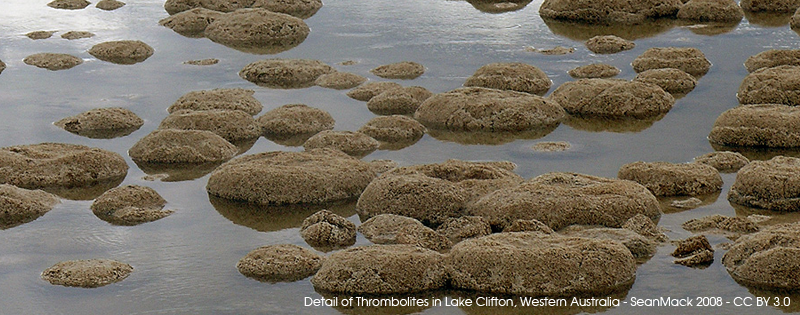Whilst watching a documentary on ABC TV, I saw what I thought were stromatolites, only to learn that they were called “thrombolites”. I couldn’t recall having heard of thrombolites. These ones were located at Lake Clifton in Western Australia.
According to Wikipedia, “Thrombolites are clotted accretionary structures formed in shallow water by the trapping, binding, and cementation of sedimentary grains by biofilms of microorganisms, especially cyanobacteria (commonly known as blue-green algae).” It goes on to say that “Stromatolites are similar but consist of layered accretions.”
According to the Wikipedia entry on microbial mats, “The best known physical forms (of microbial mats) are flat mats and stubby pillars called stromatolites, but there are also spherical forms. Microbial mats are the earliest form of life on Earth for which there is good fossil evidence, from 3,500 million years ago, and have been the most important members and maintainers of the planet’s ecosystems. Originally they depended on hydrothermal vents for energy and chemical “food”, but the development of photosynthesis gradually liberated them from the “hydrothermal ghetto” by proving a more widely available energy source, sunlight, although initially the photosynthesizing mats still depended on the diffusion of chemicals emitted by hydrothermal vents. The final and most significant stage of this liberation was the development of oxygen-producing photosynthesis, since the main chemical inputs for this are carbon dioxide and water.
“As a result microbial mats began to produce the atmosphere we know today, in which free oxygen is a vital component. At around the same time they may also have been the birthplace of the more complex eukaryote type of cell, of which all multicellular organisms are composed. Microbial mats were abundant on the shallow seabed until the Cambrian substrate revolution, when animals living in shallow seas increased their burrowing capabilities and thus broke up the surfaces of mats and let oxygenated water into the deeper layers, poisoning the oxygen-intolerant micro-organisms that lived there. Although this revolution drove mats off soft floors of shallow seas, they still flourish in many environments where burrowing is limited or impossible, including rocky seabeds and shores, hyper-saline and brackish lagoons, and are found on the floors of the deep oceans.”
Further on, it states, “The best-known types of microbial mat may be flat laminated mats, which form on approximately horizontal surfaces, and stromatolites, stubby pillars built as the microbes slowly move upwards to avoid being smothered by sediment deposited on them by water. However there are also spherical mats, some on the outside of pellets of rock or other firm material and others inside spheres of sediment.”

